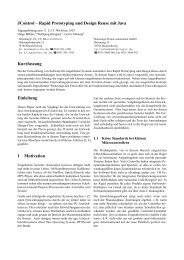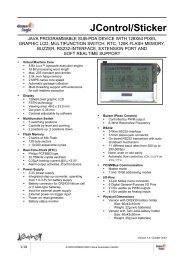JControl/SmartDisplay - DOMOLOGIC Home Automation GmbH
JControl/SmartDisplay - DOMOLOGIC Home Automation GmbH
JControl/SmartDisplay - DOMOLOGIC Home Automation GmbH
Create successful ePaper yourself
Turn your PDF publications into a flip-book with our unique Google optimized e-Paper software.
GPIO #9/KB_IN<br />
R1<br />
10kΩ<br />
+5V<br />
Table 2 lists the resistor values for an analog<br />
keyboard with up to 10 keys, using a pull-up<br />
resistor R1 of 10kΩ. The voltage created by the<br />
voltage dividers is increased by steps of VDDA/10,<br />
starting at 0V. Because of resistor tolerances, the<br />
resulting voltages and the measured ADC value<br />
may differ in real applications. Hence, the<br />
integrated keyboard decoder uses thresholds<br />
between two theoretical values for key detection.<br />
The keys decoded by the key panel shown in Fig.<br />
7 are ‘up’, ‘down’, ‘left’, ‘right’ and ‘select’,<br />
corresponding to the letters ‘U’, ‘D’, ‘L’, ‘R’ and ‘S’.<br />
The letters are returned by the method read() of<br />
the class jcontrol.io.Keyboard, when one of<br />
the keys is pressed. The letters are defined by the<br />
default keyboard map, that may be changed by an<br />
application program for software compatibility<br />
reasons.<br />
Note that the keys are prioritized, i. e. always the<br />
key with the lowest order number is decoded, if<br />
various keys are pressed simultaneously. The first<br />
REAL TIME CLOCK (RTC)<br />
The <strong>JControl</strong>/<strong>SmartDisplay</strong> implements a software<br />
emulated Real Time Clock (RTC), controlled by<br />
the system software. Hence, this “RTC” is clocked<br />
by the on-board ceramic resonator. It provides<br />
year, month, day, weekday, hours, minutes and<br />
seconds. Besides the current time, an alarm time<br />
is also provided. When the current time reaches<br />
the alarm time, a dedicated alarm flag is set.<br />
BUZZER CONTROL<br />
R2 R3 R4<br />
1100Ω 1300Ω 1800Ω<br />
'S' 'U' 'D' 'L'<br />
The <strong>JControl</strong>/<strong>SmartDisplay</strong> supports an external<br />
buzzer, connectable to pin 10 of the device. The<br />
buzzer may be used for acoustic signals<br />
generated by the system or by an application.<br />
The system will use the buzzer for acoustic<br />
feedback on keyboard events and for signalling<br />
system exceptions. Both features may be enabled<br />
or disabled by using the system properties<br />
Fig. 7: Schematic of a cursor-control analog key panel<br />
6/18 © 2003-2006 <strong>DOMOLOGIC</strong> <strong>Home</strong> <strong>Automation</strong> <strong>GmbH</strong><br />
R5<br />
2400Ω<br />
'R'<br />
<strong>JControl</strong>/<strong>SmartDisplay</strong><br />
key (letter ‘S’) is also used to enter the download<br />
mode when pressed during reset.<br />
Key<br />
Nr.<br />
more keys<br />
...<br />
Letter R Resistor<br />
Value<br />
'U'<br />
'D'<br />
V ADC<br />
Value<br />
1 ‘S’ 0Ω 0 0<br />
2 ‘U’ R2 1100Ω 0.5 25<br />
3 ‘D’ R3 1300Ω 1.0 50<br />
4 ‘L’ R4 1800Ω 1.5 76<br />
5 ‘R’ R5 2400Ω 2.0 102<br />
6 ‘N’ R6 3300Ω 2.5 127<br />
7 ‘P’ R7 5100Ω 3.0 153<br />
8 ‘E’ R8 8200Ω 3.5 179<br />
9 ‘H’ R9 16000Ω 4.0 204<br />
10 ‘X’ R10 51000Ω 4.5 230<br />
Table 2: Resistor values for the Analog Keyboard<br />
'S'<br />
'L' 'R'<br />
Analog keyboards are not suitable for silicone<br />
rubber keys, because of their varying and<br />
pressure-dependent contact resistances. Use<br />
external hardware, e.g. logic buffers, to reduce the<br />
contact resistance in this case.<br />
The built-in class jcontrol.system.RTC<br />
implements methods for reading and writing the<br />
current time and the alarm time. A time<br />
information is represented by an instance of the<br />
built-in class jcontrol.system.Time,<br />
combining the fields year, month, day, weekday,<br />
hours, minutes and seconds.<br />
buzzer.systembeep (system execeptions) and<br />
buzzer.keyboardbeep. Additionally, an<br />
application software may control the buzzer using<br />
the external class jcontrol.io.Buzzer,<br />
implementing the interface<br />
jcontrol.io.SoundDevice for hardware<br />
abstraction. This class provides methods to<br />
activate the buzzer using a specified frequency<br />
(250...32767Hz) for a specified duration (in ms).






